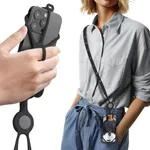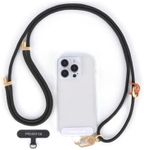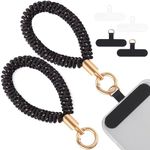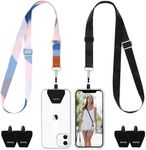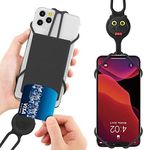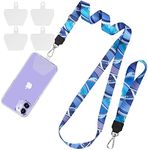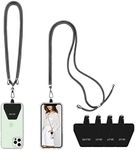Buying Guide for the Best Cell Phone Lanyards
Choosing the right cell phone lanyard can make carrying your phone more convenient and secure, especially if you’re often on the go or want to keep your hands free. The best lanyard for you will depend on how you plan to use it, your comfort preferences, and the environments where you’ll be carrying your phone. By understanding the key features, you can find a lanyard that fits your lifestyle and keeps your phone accessible and safe.MaterialThe material of a cell phone lanyard affects its comfort, durability, and appearance. Common materials include nylon, polyester, silicone, and leather. Nylon and polyester are lightweight and strong, making them good for everyday use. Silicone is soft and flexible, which can be more comfortable against your skin. Leather offers a more stylish look but may require more care. If you want something for active use or outdoor activities, choose a durable, sweat-resistant material. For daily wear or professional settings, you might prefer something softer or more stylish.
Attachment MechanismThis refers to how the lanyard connects to your phone. Some lanyards use a universal patch that fits inside your phone case, while others have clips, loops, or adhesive pads. Universal patches are versatile and don’t require special cases, while clips and loops may be more secure but could require a case with a dedicated hole. Adhesive pads are easy to use but may not be as durable. Consider how often you’ll remove your phone from the lanyard and whether you want a permanent or temporary attachment.
Length and AdjustabilityLanyards come in different lengths, from short wrist straps to long neck or crossbody styles. Some are adjustable, allowing you to change the length for comfort or convenience. Short lanyards are good for keeping your phone close at hand, while longer ones let you wear your phone around your neck or across your body. If you want flexibility, look for an adjustable lanyard. Think about how you’ll use your phone—if you need quick access, a shorter or wrist lanyard might be best; for hands-free carrying, a longer or adjustable one is ideal.
Weight CapacityThis spec tells you how much weight the lanyard can safely hold. Most lanyards are designed for standard smartphones, but if you have a heavier phone or use a bulky case, check the weight limit. A lanyard with a higher weight capacity will be more durable and less likely to break. If you carry extra items like keys or ID badges with your phone, make sure the lanyard can handle the combined weight.
Safety FeaturesSome lanyards include safety features like breakaway clasps, which automatically release if the lanyard is pulled too hard. This is important for preventing accidents or injuries, especially if you’re active or work in environments where the lanyard could get caught. If safety is a concern, look for a lanyard with a breakaway feature. For general use, this may not be as critical, but it’s a good option for added peace of mind.
Style and ColorLanyards come in a wide range of colors and designs, from simple and professional to bright and decorative. The style you choose can reflect your personality or match your outfit. If you want your lanyard to blend in, choose neutral colors. If you want it to stand out or be easy to find, go for bold colors or patterns. Think about where you’ll use the lanyard and whether you want it to be a fashion accessory or just a practical tool.
